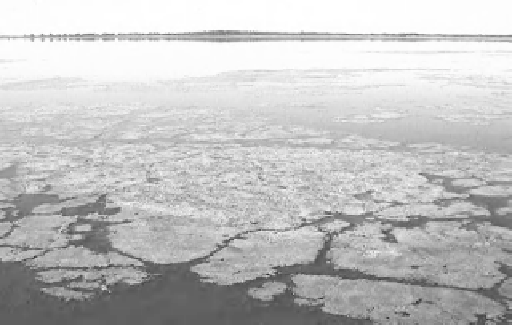Environmental Engineering Reference
In-Depth Information
organic carbon are the most commonly used measures
of plant concentration in lakes and reservoirs, as well as
in some slow-moving streams. When the concentration
of phytoplankton algae during the late summer period
exceeds a certain threshold nuisance value, the situation
is called an
algae bloom
. Benthic levels of chlorophyll
a
are sometimes used to measure the acceptability of
waters for recreational use, and benthic concentrations
less than 150 Chl
a
/m
2
are typically found to be
acceptable.
7.3.1 Biomass-Nutrient Relationships
At least 19 elements are essential for life, and these
basic elements are collectively called
nutrients
. Five of
these nutrients are required in large amounts: carbon,
hydrogen, oxygen, nitrogen, and phosphorus. The first
three (C, H, and O) are readily available in either water
(H
2
O) or dissolved carbon dioxide (CO
2
) and are never
long-term limiting factors for aquatic plant growth.
However, the concentrations of nitrogen and phospho-
rus dissolved in natural waters are much lower, and it is
usually one of these two elements that provides the
limiting factor for aquatic plant growth. Consequently,
nitrogen and/or phosphorus are usually considered
responsible for eutrophication in natural water bodies.
According to
Liebig's law of the minimum
, growth is
limited by the essential nutrient that is in lowest supply.
If all nutrients are available in adequate supply, massive
algal and macrophyte blooms may occur, with severe
consequences. Most commonly in lakes, phosphorus is
the limiting nutrient for aquatic plant growth. In these
situations, adequate control of phosphorus, particularly
from anthropogenic sources, can control the growth of
nuisance aquatic vegetation.
Nutrients are consistently identified as the cause of
lake impairments more than any other pollutants (Ji,
2008). Lakes that receive a major portion of their nutri-
ents from internal sources are called
autotrophic
, and
those that receive a major portion of their nutrients
from external sources are called
allotrophic
. In related
terminology,
allochthonous
nutrients are those originat-
ing from the watershed contributing inflow to the lake,
usually from nonpoint sources, while
autochthonous
nutrient sources include nutrients stored in the lake
water and sediments.
Nitrogen and phosphorus are discharged into surface
waters primarily via agricultural and urban runoff,
municipal and industrial discharges, and combined
sewer overflows. Phosphorus and nitrogen usually occur
in a variety of combined forms, and it is common
to quantify their concentrations in terms of
total
phosphorus
(TP) and
total nitrogen
(TN). The combined
forms of phosphorus and nitrogen that contribute to TP
Figure 7.4.
Algae mat.
Source
: Aber (2002).
A general trend that results from eutrophication is
an increase in the numbers of organisms and a decrease
in diversity of species, particularly among nonmotile
species. Species associated with eutrophic systems are
sometimes less desirable than species characteristic of
oligotrophic systems. Cyanobacteria, which are fre-
quently associated with organic nutrient enrichment,
are a class of organisms frequently associated with
undesirable water-quality conditions. Large-scale fish
kills and the elimination of desirable species as a result
of oxygen depletion may constitute a serious eutrophi-
cation consequence in some aquatic systems. High-
elevation and high-latitude lakes can sustain only a few
tolerant species of organisms and fish, and due to the
cold water temperatures, they may not be desirable for
primary contact recreation. Due to their aesthetic and
natural values and due to the high sensitivity of the
resident aquatic biota, such water bodies require a high
degree of protection.
Aquatic plants, including algae, that grow in surface
waters can be broadly classified according to whether
they move freely in the water or remain fixed in place.
Plants that move freely in water are called
phytoplank-
ton
(e.g., free-floating algae); attached plants include
periphyton
(e.g., attached or benthic algae) and
macro-
phytes
(rooted, vascular aquatic plants). The types of
attached plant communities depend on the depth and
clarity of the water. The level of eutrophication in lakes
and reservoirs is usually measured by the amount of
phytoplankton per unit volume of water, with com-
monly used measures including (1) total dry weight
(g/L), (2) carbon contained in phytoplankton (mg/L),
(3)
chlorophyll a
contained in phytoplankton (
µ
g/L), or
(4) oxygen demand necessary to decompose the phyto-
plankton (mg O
2
/L). Chlorophyll
a
is the (green) pho-
tosynthetic pigment found in all algae, and is, therefore,
a direct indicator of algal biomass. Chlorophyll
a
and

Search WWH ::

Custom Search